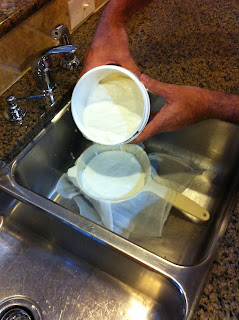| French Neufchatel - note the bloomy rind similar to Camembert |
The US version is a very different product.
Various references suggest that in 1872, while marking Neufchatel with lower fat milk a William Lawrence of Chester, New York produced a cream cheese alternative - what every the exact history the US product is most defiantly not Neufchatel but is most defiantly delicious.
Eaten fresh (0-2 weeks) this is a mildly fermented soft and creamy cheese that is ideal for use as a spread or as a replacement for cream cheese. What I like about it is that it has a lower fat level and a slightly fuller taste that cream cheese. This one was based on whole milk at 3.5% butterfat rather than cream at 12-18% butterfat.
The process is interesting in that the milk is fermented at a low temperature (room temp) for up to 24 hours and then drained for a similar time - the result is a soft and creamy cheese with a mild flavor that continues to develop and firm across time.
Ingredients
1/2 gallon whole organic milk
1/16 tsp mesophilic direct set starter
10 drops calcium chloride
10 drops double strength liquid rennet
cheese cloth
1 tablespoon cheese salt
Optional
colander
pH strips
cheese mat
yogurt maker
herbs
Method
 |
| Dilute and add rennet and calcium chloride, add mesophilic starter and stir for 3 minutes |
 |
| Transfer to a yogurt maker or a container that will allow the milk to ferment at 70 F |
 |
| Ferment for 24 hours, a soft curd had formed , similar to a firm set yogurt |
 |
| The pH of the curd was 4.5-5.0 |
 |
| Line a colander with cheese cloth and add curds |
 |
| AT 24 hours the curds had drained |
 |
| Unwrap curds, place ion a bowel and add a tablespoon of cheese salt, mix well |
 |
| Add herbs and form into logs or balls. The cheese is very creamy. I found that forming it in cling wrap into logs , with the use of a draining mat or into balls helped. |




No comments:
Post a Comment